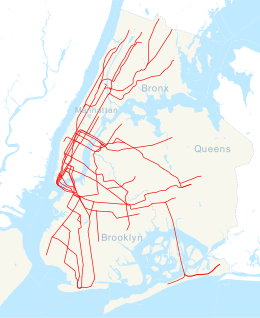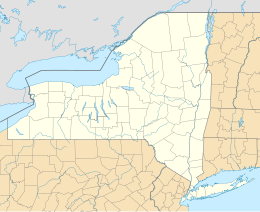Third Avenue station (BMT Canarsie Line)
The Third Avenue station is a station on the BMT Canarsie Line of the New York City Subway. Located at the intersection of Third Avenue and East 14th Street in East Village, Manhattan,[3][4] it is served by the L train at all times.
3 Avenue | ||||||||||||||||||||||||||||||||||||||||||||||||||||||||||||||||||||
|---|---|---|---|---|---|---|---|---|---|---|---|---|---|---|---|---|---|---|---|---|---|---|---|---|---|---|---|---|---|---|---|---|---|---|---|---|---|---|---|---|---|---|---|---|---|---|---|---|---|---|---|---|---|---|---|---|---|---|---|---|---|---|---|---|---|---|---|---|
 Southbound platform with L train in the distance | ||||||||||||||||||||||||||||||||||||||||||||||||||||||||||||||||||||
| Station statistics | ||||||||||||||||||||||||||||||||||||||||||||||||||||||||||||||||||||
| Address | Third Avenue & East 14th Street New York, New York | |||||||||||||||||||||||||||||||||||||||||||||||||||||||||||||||||||
| Borough | Manhattan | |||||||||||||||||||||||||||||||||||||||||||||||||||||||||||||||||||
| Locale | East Village, Stuyvesant Square | |||||||||||||||||||||||||||||||||||||||||||||||||||||||||||||||||||
| Coordinates | 40°44′00″N 73°59′14″W / 40.733243°N 73.987212°W | |||||||||||||||||||||||||||||||||||||||||||||||||||||||||||||||||||
| Division | B (BMT)[1] | |||||||||||||||||||||||||||||||||||||||||||||||||||||||||||||||||||
| Line | BMT Canarsie Line | |||||||||||||||||||||||||||||||||||||||||||||||||||||||||||||||||||
| Services | L | |||||||||||||||||||||||||||||||||||||||||||||||||||||||||||||||||||
| Transit | ||||||||||||||||||||||||||||||||||||||||||||||||||||||||||||||||||||
| Structure | Underground | |||||||||||||||||||||||||||||||||||||||||||||||||||||||||||||||||||
| Platforms | 2 side platforms | |||||||||||||||||||||||||||||||||||||||||||||||||||||||||||||||||||
| Tracks | 2 | |||||||||||||||||||||||||||||||||||||||||||||||||||||||||||||||||||
| Other information | ||||||||||||||||||||||||||||||||||||||||||||||||||||||||||||||||||||
| Opened | June 30, 1924 | |||||||||||||||||||||||||||||||||||||||||||||||||||||||||||||||||||
| Opposite- direction transfer | No | |||||||||||||||||||||||||||||||||||||||||||||||||||||||||||||||||||
| Traffic | ||||||||||||||||||||||||||||||||||||||||||||||||||||||||||||||||||||
| 2023 | 1,564,084[2] | |||||||||||||||||||||||||||||||||||||||||||||||||||||||||||||||||||
| Rank | 209 out of 423[2] | |||||||||||||||||||||||||||||||||||||||||||||||||||||||||||||||||||
| ||||||||||||||||||||||||||||||||||||||||||||||||||||||||||||||||||||
| ||||||||||||||||||||||||||||||||||||||||||||||||||||||||||||||||||||
| ||||||||||||||||||||||||||||||||||||||||||||||||||||||||||||||||||||
| ||||||||||||||||||||||||||||||||||||||||||||||||||||||||||||||||||||
| ||||||||||||||||||||||||||||||||||||||||||||||||||||||||||||||||||||
History
editContract 4 of the Dual Contracts, adopted on March 4, 1913 between New York City and the Brooklyn Rapid Transit Company, included a subway route under 14th Street, to run to Canarsie in Brooklyn; this became the BMT's Canarsie Line.[5]: 203–219 [6]
Booth and Flinn was awarded the first contract for the line, namely a tunnel under the East River, in January 1916.[7] At the time, the Public Service Commission was completing plans for the rest of the line;[8] the commission began accepting bids for two parts of the line within Manhattan, sections 1 and 2. in April 1916.[9] The next month, Booth and Flinn won the contract for section 1, which was to cost $2.528 million (equivalent to $70.784 million in 2023).[10] By early 1919, the section of the line under 14th Street was about 20 percent completed.[11]
In 1922, the Charles H. Brown & Son Corporation was contracted to build out the Canarsie Line's stations in Manhattan, including the Third Avenue station.[12] Track-laying in the tunnels between Sixth and Montrose Avenues started in the last week of October 1922.[13][14] The Third Avenue station at Union Square opened on June 30, 1924, as part of the 14th Street–Eastern Line, which ran from Sixth Avenue under the East River and through Williamsburg to Montrose and Bushwick Avenues.[15][16]
Station layout
edit| Ground | Street level | Exit/entrance |
| Platform level | Side platform | |
| Westbound | ← toward Eighth Avenue (Union Square) | |
| Eastbound | toward Canarsie–Rockaway Parkway (First Avenue) → | |
| Side platform | ||
This station has two side platforms, which are 500 feet (150 m) long, and two tracks. West of the station, there is a double crossover.[17] The platforms are column-less and have the standard BMT style trim-line and name tablets. The former contains "3" tablets in standard intervals, while the latter consists of "THIRD AVE" in seriffed lettering.
There are also directions signs to the station's only entrances/exits saying "TO STREET" in the same style as the name tablets. Each platform has its own same-level fare control at the extreme west (railroad north) end. As a result, there is no free transfer between directions.
Third Avenue is one of only two stations along the Canarsie Line in Manhattan that does not contain a transfer to another line. The other station is the nearby First Avenue Subway station. However, a transfer station is planned to the 14th Street station of the Second Avenue Subway, as part of Phase 3 of the line's construction from 55th Street to Houston Street.[18]
Exits
editEach platform-level fare control area has a bank of turnstiles, token booth, and two street stairs apiece—one to the east side of Third Avenue and East 14th Street, the other to East 14th Street just east of Third Avenue. The stairs on the Eighth Avenue-bound side lead to the northeast corner, while the ones on the Brooklyn-bound side lead to the southeast corner.[4]
Experimental platform doors
editAs part of a pilot program, each platform at the Third Avenue station was supposed to be refitted with 32 half-height platform screen doors (PSDs) while the 14th Street Tunnel was being rebuilt from April 2019 to March 2020. This had been possible as a result of the L train's automated train operation, as well as the route's exclusive use of 60-foot-long (18 m) subway cars with four doors, which allow trains to stop at the same part of the platform every time. The MTA would have used the results of the pilot in order to determine the feasibility of adding such doors citywide.[19] The PSDs would have been approximately 54 inches (140 cm) high and would have been coordinated with the location of the subway car doors when a train was in the station.[20]
To ensure that the subway car is precisely lined up with the doors, a wayside-only berthing system would be installed. Emergency egress gates would be installed in between the regular doors to allow people to exit in the case of an emergency. The platform edges and topping would be removed and replaced so that they align with the sills of the train doors and to be in compliance with the Americans with Disabilities Act of 1990. To ensure that people do not get trapped in between the subway car doors and the PSDs, sensors and CCTV cameras would be installed with monitors at the center and front of the platforms visible to the train operator and conductor.[21]
In June 2018, the $30 million for the platform edge door pilot program was diverted to another project along the Canarsie Line: the installation of elevators at the Sixth Avenue station. The pilot program was postponed until sufficient funding could be found.[22] In February 2022, the MTA announced that the PSD installation at Third Avenue would proceed as part of a pilot program involving three stations.[23][24] The announcement came after several people had been shoved onto tracks, including one incident that led to a woman's death at another station.[24] The MTA started soliciting bids from platform-door manufacturers in mid-2022;[25] the doors are planned to be installed starting in December 2023 at a cost of $6 million.[26] Designs for the platform doors were being finalized by June 2023.[27][28]
References
edit- ^ "Glossary". Second Avenue Subway Supplemental Draft Environmental Impact Statement (SDEIS) (PDF). Vol. 1. Metropolitan Transportation Authority. March 4, 2003. pp. 1–2. Archived from the original (PDF) on February 26, 2021. Retrieved January 1, 2021.
- ^ a b "Annual Subway Ridership (2018–2023)". Metropolitan Transportation Authority. 2023. Retrieved April 20, 2024.
- ^ "East Village, Manhattan Senior Pedestrian Crashes 2001-2006" (PDF). nyc.gov. Archived from the original (PDF) on June 26, 2022.
- ^ a b "MTA Neighborhood Maps: East Village" (PDF). Metropolitan Transportation Authority. 2015. Retrieved August 6, 2015.
- ^ Walker, James Blaine (1918). Fifty Years of Rapid Transit — 1864 to 1917. New York, N.Y.: Law Printing. Retrieved November 6, 2016.
- ^ "Subway Contracts Solemnly Signed; Cheers at the Ceremonial Function When McCall Gets Willcox to Attest" (PDF). The New York Times. March 20, 1913. ISSN 0362-4331. Archived (PDF) from the original on May 4, 2022. Retrieved January 11, 2018.
- ^ "East River Tunnel Contract Awarded; Booth & Flinn, Who Will Do the Work for $6,639,023, to Use the Shield Method". The New York Times. January 14, 1916. ISSN 0362-4331. Archived from the original on July 27, 2018. Retrieved July 16, 2023.
- ^ "Public Service Commission Promises to Complete Contract Awards This Year". The Brooklyn Daily Eagle. January 16, 1916. p. 40. Archived from the original on July 16, 2023. Retrieved July 16, 2023 – via Newspapers.com.
- ^ "E. D. Tube Trains Will Run in 1918". Times Union. Brooklyn. April 8, 1916. p. 15. Archived from the original on July 16, 2023. Retrieved July 16, 2023 – via Newspapers.com.
- ^ "Award Subway Contracts". Times Union. Brooklyn. May 26, 1916. p. 6. Archived from the original on July 16, 2023. Retrieved July 16, 2023 – via Newspapers.com.
- ^ "When Will Dual Subway Be Finished?: Completed Work Cost 188,332,000--unfinished Contracts Amount to 20,000,000 Two Bodies Responsible for Construction Lack Mutual Confidence and Team-work". New-York Tribune. January 5, 1919. p. D10. ISSN 1941-0646. ProQuest 575999620.
- ^ "Long Delayed E. D. Transit Relief Move Announced". The Standard Union. Brooklyn. October 29, 1922. pp. 9, 11. Archived from the original on June 11, 2021. Retrieved June 11, 2021 – via Newspapers.com.
- ^ "Laying of Tracks Starts New Action for Thru Tubes". The Chat. Brooklyn. November 4, 1922. p. 18. Archived from the original on June 11, 2021. Retrieved June 11, 2021 – via Newspapers.com.
- ^ "Long Delayed E. D. Transit Relief Move Announced". The Standard Union. Brooklyn. October 29, 1922. pp. 9, [1]. Archived from the original on July 17, 2023. Retrieved July 16, 2023 – via Newspapers.com.
- ^ "Celebrate Opening of Subway Link" (PDF). The New York Times. July 1, 1924. p. 23. Retrieved February 13, 2010.
- ^ "Pushing Throng Christens Spur Of B. M. T. Tube: Hylan Runs the First Train From Brooklyn to 14th Street, Then Assails "Interests'" at Luncheon Yearns to Boss System Transit Commission Heads Remind Mayor Epithets Won't Solve Problems". The New York Herald, New York Tribune. July 1, 1924. p. 12. ISSN 1941-0646. ProQuest 1112998377.
- ^ Dougherty, Peter (2006) [2002]. Tracks of the New York City Subway 2006 (3rd ed.). Dougherty. OCLC 49777633 – via Google Books.
- ^ "Figure 2-1 New York City Subway Service with Second Avenue Subway Line" (PDF). mta.info. Metropolitan Transportation Authority. Retrieved June 5, 2016.
- ^ Barone, Vin (October 24, 2017). "Platform door pilot heads to L train station". am New York. Retrieved October 25, 2017.
- ^ "New York City Transit and Bus Committee Meeting" (PDF). Metropolitan Transportation Authority. December 13, 2017. p. 145. Archived from the original (PDF) on December 28, 2017. Retrieved November 9, 2017.
- ^ "C-32518: Design, Build, Furnish & Maintain a Platform Barrier Door System at the 3rd Avenue Station on the Canarsie Line, Borough of Manhattan" (PDF). mta.info. Metropolitan Transportation Authority. February 20, 2018. Archived from the original (PDF) on March 16, 2018. Retrieved March 15, 2018.
- ^ Berger, Paul (June 26, 2018). "MTA Postpones Platform-Safety Pilot Program". Wall Street Journal. ISSN 0099-9660. Retrieved June 26, 2018.
- ^ Gold, Michael (February 23, 2022). "Subway Will Test Platform Doors at 3 Stations". The New York Times. ISSN 0362-4331. Retrieved February 23, 2022.
- ^ a b Brosnan, Erica (February 23, 2022). "MTA: Platform barrier pilot program to launch in three stations". Spectrum News NY1 | New York City. Retrieved February 23, 2022.
- ^ Martinez, Jose; Pedraza, Candace (July 15, 2022). "MTA Opens Door to Platform Barriers in Three Subway Stations". The City. Retrieved October 6, 2022.
- ^ "Project Details: Platform Screen Doors (PSD) Pilot: 3 Stations". MTA. Retrieved October 6, 2022.
- ^ Heyward, Giulia (June 4, 2023). "MTA set to install protective platform doors at select subway stations in 'coming months'". Gothamist. Retrieved June 5, 2023.
- ^ Troutman, Matt (June 5, 2023). "Three NYC Subway Stations Will Get Platform Doors: Report". New York City, NY Patch. Retrieved June 5, 2023.
External links
edit- nycsubway.org – BMT Canarsie Line: 3rd Avenue
- Station Reporter — L Train
- The Subway Nut — 3rd Avenue Pictures
- Third Avenue entrance from Google Maps Street View
- Platforms from Google Maps Street View



